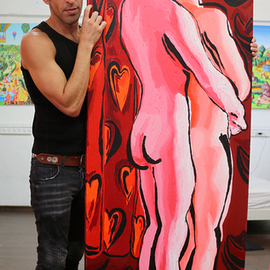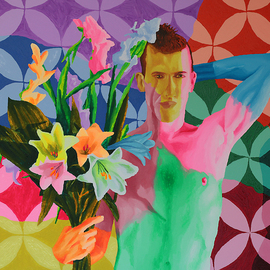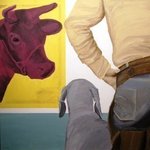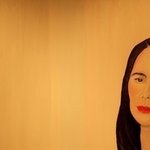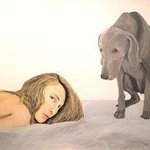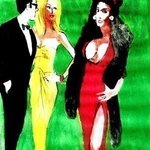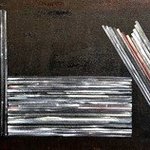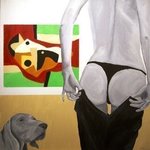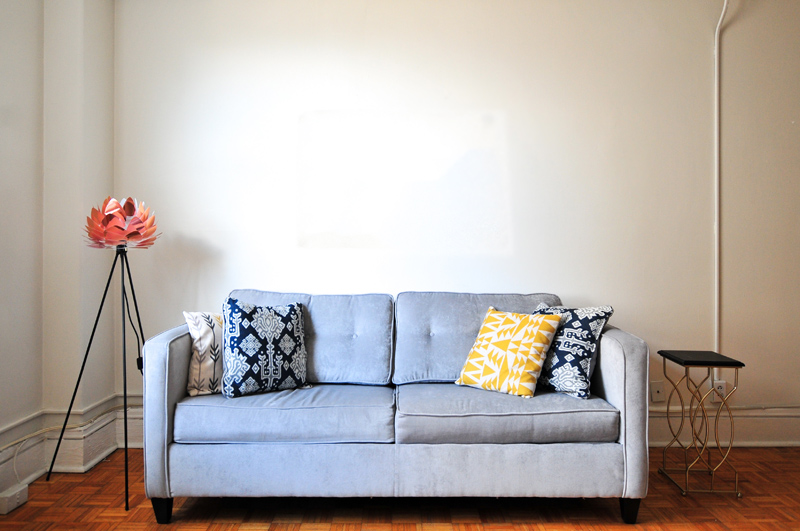Homoerotic Artwork Homosexual Art Raphael Perez Painting By Raphael Perez Israeli Painter
Art For Sale ❯ Paintings ❯ Raphael Perez Israeli Painter ❯ Figuratives ❯
All Artworks ❯
Painting Acrylic ❯
Raphael Perez Israeli Painter ❯
Figurative ❯
Homoerotic Artwork Homosexual Art Raphael Perez
Artist:
Raphael Perez Israeli Painter
Title:
Homoerotic Artwork Homosexual Art Raphael Perez
Price:
Sold
Year:
2004
Medium:
Size - (USA):
100 W x 150 H x 3 D (cm)
Size - (metric):
39.4 W x 59.1 H x 1.2 D (inches)
Theme:
Edition:
Original
Artwork ID:
401207
PDF Copy:
Artwork Description:
Article about Raphael Perez homosexual gay art paintings Pride and Prejudice on Raphael Perezs Artwork Raphael Perez, born in 1965, studied art at the College of Visual Arts in Beer Sheva, and from 1995 has been living and working in his studio in Tel Aviv. Today Perez plays an important role in actively promoting the LGBT lesbian, gay, bisexual and transsexual art and culture in Tel Aviv, and the internet portal he set up helps artists from the community reach large audiences in Israel and abroad. Hundreds of his artworks are part of private collections in Israel and abroad, and his artworks were shown in several group exhibitions in Tel Aviv Museum of Art, Zman LeOmanut art gallery, Camera Obscura, The Open House in Jerusalem, Ophir Gallery, The Haifa Forum and other private businesses and galleries. In 2003-4 his paintings and studio appeared in a full-length movie, three student films and two graduation films. Raphael Perez is the first Israeli artist to express his lifestyle as a Gay. His life and the life of the LGBT community are connected and unfold over hundreds of artwork pieces. His art creation is rare and extraordinary by every Israeli and international artistic standard. His sources of inspiration are first and foremost life events intertwined in Jewish and Israeli locality as well as influences and quotes from art history David Hockney, Matisse. This uniqueness has crossed international borders and has succeeded in moving the LGBT and art communities around the world. This is the first time we meet an Israeli artist who expresses all of his emotions in a previously unknown strength. The subjects of the paintings are the everyday life of couples in everyday places and situations, along with the aspiration to a homosexual relationship and family, equality and public recognition. Perezs works bring forward to the cultural space and to the public discourse the truth about living as LGBT and about relationships, with all of their aspects � casual relationships and sex, the yearning for love, the everyday life and the mundane activities that exist in every romantic relationship � whether by describing two men in an intimate scene in the bathroom, the bedroom or the toilet, a male couple raising a baby or the homosexual version of the Garden of Eden, family dinners, relationship ups and downs, the complexity in sharing a life as well as mundane, everyday life competing with the aspiration to self realization through Perezs life. Perezs first artworks are personal diaries, which he creates at 14 years of age. He makes sure to hide these diaries, as in them he keeps a personal journal describing his life events in the most genuine way. In these journals he draws thousands of drawings and sketches, next to which he alternately writes and erases his so-called problematic texts, texts describing his struggle with his sexual orientation. His diaries are filled with obsessive cataloging of details, daily actions, friends and work, as well as repeating themes, such as thoughts, exhibits he has seen, movies, television, books and review of his work. When he is done writing, Perez draws on his diaries. Each layer is done from beginning to end all along the journal. In fact, the work on the diaries never ends. This struggle never ends, and when the emotion is passed on to paper, and it ends its role and becomes meaningless in a way, the visual-graphic side becomes dominant, due to the need to hide the written text, according to Perez. In books and diaries this stands out even more � when he chooses to draw in a style influenced by childrens drawings, the characters are cheerful, happy, na�ve and do not portray any sexuality, and when he tries drawing as an adult the sketches became more depressed and somber. During these years Perez works with preschool children, teaching them drawing and movement games. Perez says that during this period he completely abandoned the search for a relationship, either with a woman or a man, and working with children has given him existential meaning. This creation continues over 10 years, and Perez creates about 60 books-personal journals in various sizes notepads, old notebooks, atlases and even old art books. In his early paintings 1998-1999 the transition from relationships with women to relationships with men can be seen, from restraint to emotional outburst in color, lines and composition. Some characters display strong emotional expression. The women are usually drawn in restraint and passiveness, while a happy and loving emotional outburst is expressed in the colors and style of the male paintings. I fantasized that in a relationship with a woman I could fly in the sky, love, fly. However, I felt I was hiding something I was choked up, hidden behind a mask, as if there was an internal scream wanting to come out. I was frustrated, I felt threatened� His first romance with a man in 1999 has drawn out a series of na�ve paintings dealing with love and the excitement of performing everyday actions together in the intimate domestic environment. The excitement from each everyday experience of doing things together and the togetherness was great, so I painted every possible thing I liked doing with him. From the moment the self-oppression and repression stopped, Perez started the process of healing, which was expressed in a burst of artworks, enormous in their size, amount, content and vivid colors red, pink and white. In 2000 Perez starts painting the huge artworks describing the hangouts of the LGBT community The Lake, The Pool and the Tel Avivian balcony paintings describing the masculine world, which, according to him, becomes existent thanks to the painting. Perez has dedicated this year to many series of drawings and paintings of the experience of love, in which he describes his first love for his new partner, and during these months he paints from morning to night. These paintings are the fruit of a long dialogue with David Hockney, and the similarity can be seen both in subjects and in different gestures. In 2001 Perez creates a series of artworks, Portraits from The Community. Perez describes in large, photorealistic paintings over 20 portraits of active and well-known members of the LGBT community. The emphasis is on the achievements that reflect the communitys strong standing in Tel Aviv. As a Tel-Avivian painter, in the past two years Perez has been painting urban landscapes of central locations in his city. Perez wanders around the city and chooses familiar architectural and geographical landmarks, commerce and recreation, and historical sites, and paints them from a homosexual point of view, decorated with the rainbow flag, which provide a sense of belonging to the place. His artworks are characterized by a cheerful joie de vivre and colors, and they also describe encounters and meetings. The touristic nature of his paintings makes them a declaration of Tel Avivs image as a place where cultural freedom prevails. Perezs Tel Aviv is a city where young families and couples live and fill the streets, the parks, the beach, the houses and the balconies � all the citys spaces. The characters in his paintings are similar, which helps reinforcing the belonging to the LGBT community in Tel Aviv. The collective theme in Perezs artwork interacts with the work of the Israeli artist Yohanan Simon, who dealt with the social aspects of the Kibbutz. Simon, who lived and worked in a Kibbutz, expressed the human model of the Kibbutznik member of a Kibbutz and the uniqueness of the Kibbutz members as part of a group where all are equal. Simons works, and now Perezs, have contributed to the Israeli society what is has been looking for endlessly, which is a sense of identity and belonging. Perez maps his territory and marks his boundaries, and does not forget the historical sites. Unlike other Tel Avivian artists, Perez wishes to present the lives of the residents of the city and the great love in their hearts. By choosing the historical sites in Tel Aviv, he also pays tribute to the artist Nachum Gutman, who loved the city and lived in it his whole life. In his childhood Gutman experienced historical moments lighting the first oil lamp, first concert, first pavement, and as an adult he recreated the uniqueness of those events while keeping the citys magic. Like Gutman, Perez has also turned the city into an object of love, and it has started adorning itself in rich colors and supplying the energy of a city that wishes to be the city that never sleeps, combining old and new. Perez meticulously describes the uniqueness and style of the Bauhaus houses and balconies along the modern glass and steel buildings, all from unusual angles in a rectangular format that wishes to imitate the panorama of a diverse city in its centennial celebrations. Daniel Cahana-Levensohn, curator.
Keywords:
Original Painting, Figurative Painting








